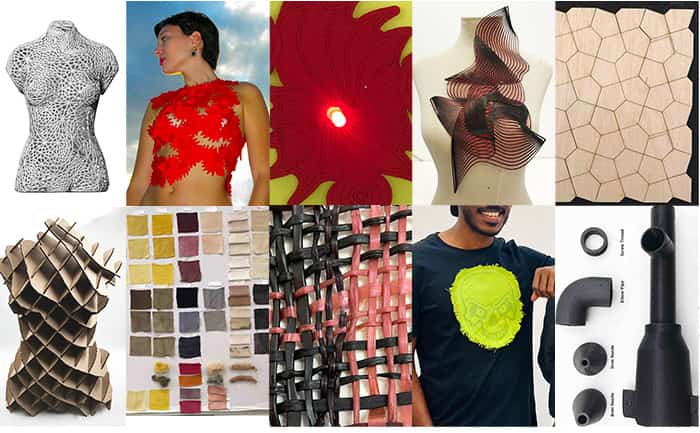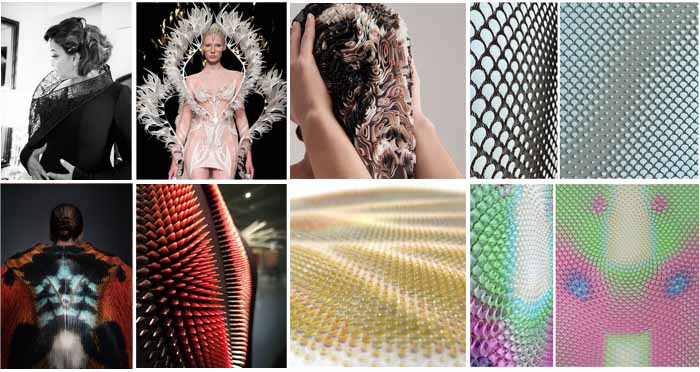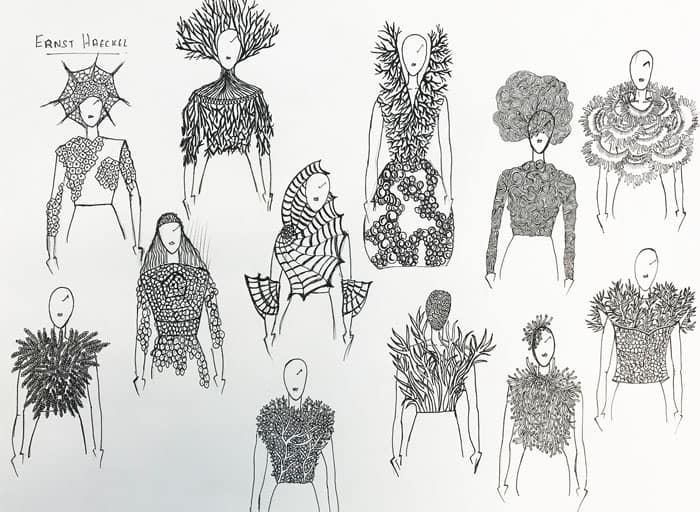11. Implications and applications¶
As I began to work on our final project concept, I took a step back and reflected on all of the learning I have gained through Fabricademy. The amount of learning we accomplished in such a short time was overwhelming. As you can see, I have completed some of my projects with Fabricademy so far and how some of those projects have been related to my interests and have connections to my earlier learnings, which has led me to develop a concept and plan for my final project.

Inspiration¶
The following are some of the designer's works that I find highly inspiring.
Research & Concept¶
My goal is to explore the field of computational couture in greater detail. In one word, I would say the inspiration for my art is "Nature." The endless amount of organic shapes and patterns that you can discover under microscopic view completely blew me away. One of my favourite examples would be the work of Ernst Haeckel, an artist, marine biologist, and naturalist who discovered a lot of new species and influenced the Art Nouveau movement during the Belle Époque period from 1890 to 1910. "Art forms of nature" is one of his published books that drew me to study in-depth about nature. Besides the designs, my art will also incorporate structural techniques like origami and pop-up art, which add volume, and a movement / transformation with an illusion effect that would give my art a sense of life. As a whole, the collection will be an amalgam of past art movements as a design and combined with present-day technologies to produce the new meaning of fashion in the future.
Brainstorming¶
To begin with, I brainstormed the keywords that were just lying around in the back of my head, so that I could put them down and see how exactly I wanted to proceed. I have arranged the words in colour order so that I can easily see the directions related to the project I wanted to work on.

Mood Board¶
A combination of various arts and techniques is reflected in the Mood collection, which I intended to explore further.

3D Printing¶
In my project, I will be using 3D printing techniques and exploring various materials and possibilities that are available in the industry. Different textile materials that are transparent and possibly sustainable adapt to 3D printing requirements and collection aesthetics. Many of my references are from Stratasys, a company that provides complete polymer 3D printing solutions.

Illusion/Movement/Transformation¶
The concept of illusion, movement, and transformation in nature fascinates me when it interacts with human movement. I would like to explore and study a few concepts in my final project, and below are some of the different techniques for inspiration.
In the first image below, the plant growth direction varies depending on the light shown in the timelapse video. Plants bend toward the sun to synthesize their food, which is natural. The process of photosynthesis requires sunlight.
In the second image, you can see the plant called mimosa pudica, also known as the touch-me-not plant. It is among the most sensitive plants on earth. In response to touch or shaking, it reacts dramatically. As soon as its leaves are lightly touched, they close, and the branch begins to close up. When you bump it harder, it responds faster and more strongly. It's so cool how nature works! Additionally, it closes at night and opens during the day, as do many other plants.
Design by Dinesh kumar
It's so fascinating to see how two different patterns intersect to create new, animated/illusionary patterns. There are many situations in which moiré patterns appear, such as physically in printing, materials, and digital products such as television and photography. Sometimes it is created deliberately as well. My interest in this topic is to study various patterns, techniques, and materials to create moire patterns for clothing.
Design by Dinesh kumar
The MIT CSAIL HCI Engineering Group has created a 3D-printed lenticular object. So, the object can change its appearance based on its viewport. By using the colour port underlying the 3D printed lens the viewers can see the different coloured from different views. The lens geometry supports 19 different viewports so we can try 19 different colours. It will be interesting to work on the same technique and explore possibilities to give a message or print in garments.
Design by Dinesh kumar
The below first images show the Origami technique. I have been working with origami for some time now. I have used basic Miura patterns and a few variations. In future, I would like to explore more shapes and techniques and figure out the movement when it contracts and expand.
The second Image shows the Pop up paper structures. It is very fascinating how it contracts to a simple flat 2D sheet and when opened up it transforms into a huge 3D structure. The best part is when spatial overlapping of the individual strips behind and next to each other creates interesting optical effects in the eye of the viewer, so-called “moiré-effects”.So it transforms and also creates an illusion. With different techniques, shapes and materials I would like to explore fabrics or other wearable materials.
Design by Dinesh kumar
The first image shows the Curling Spiral work of John Edmark. I quite liked how it spirals when it is moved. The furl happens when the two sides angle changes. It is a very interesting form to create some wearable art looks. I would like to learn the process detail to explore different shapes and materials.
The second image shows a Kinetic art structure done by Julia Nizamutdinova. I am so inspired by this structure and how it is mechanised. The tentacle form gives an amazing illusion effect when it is moved. I initially thought that the material actually moves but the interesting part is the connector that moves and the tentacles remain the same.
Design by Dinesh kumar
Initial Sketches¶

Schedule¶
